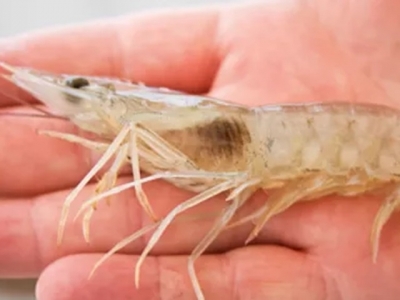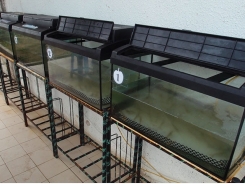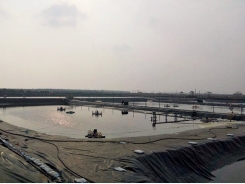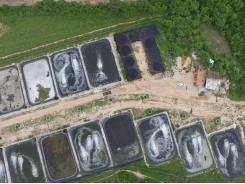Rainy season effects on shrimp grow-out ponds (Part 1)

The condition of black gills is one of the multiple manifestations of H2S toxicity in shrimp (from Lightner 2001).
Understanding water and bottom quality changes helps manage resulting risks
In this article (adapted and summarized from the original publication in Revista Acuacultura – Cámara Nacional de Acuacultura, No. 122, April 2018), I explain how heavy rains during the rainy season have direct and indirect effects on shrimp production in traditional grow-out ponds, how the effects are interrelated, what are the consequences in terms of shrimp health, and what the shrimp farmer producer can do to limit the losses associated with this climatic reality.
Although the latest forecasts from the U.S. National Oceanic and Atmospheric Administration (NOAA) point to a prolonged period of typical “La Niña” conditions, that is, droughts and low temperatures for our part of the world (Ecuador), we will continue to have very strong seasonal rains just like every year. So, the question is: What do these rains mean and how can they affect shrimp production in the short term?
Potentially, the rains can be devastating for the shrimp sector, although many times the subsequent mortalities have not been related to this climatic factor. On both sides of the South Pacific, farmed shrimp mortalities have been reported to be between 3 to 50 percent of cultured populations within three to four days of heavy rains.

Heavy rains impact water and bottom quality in shrimp ponds, and farm managers should understand these processes be prepared to manage the associated risks.
Compounding this problem is the fact that indications of imminent mortality are minimal. In this situation, there is no atypical shrimp behavior, nor presence of seagulls or other signs typical of impending production problems. Most cases reported describe a pattern of chronic mortality that could not be detected simply as a function of food consumption.
The following sections describe the physical factors directly associated with rainfall and how these factors influence the behavior of the local ecosystem. It is important to recognize that rain does not only have a direct impact on the chemical profile of the culture medium, but also drastically changes the shrimp pond’s ecological balance during an extended period many days after the rains have stopped.
Direct effects of rain
Rain generally has a temperature of 5 to 6 degrees-C lower than the environment, but it can be much lower if it is associated with massive low-pressure systems. As a result of the dissolution of carbon dioxide (CO2), rain is actually a weak solution of carbonic acid with a pH of 6.2 to 6.4 (in non-industrial areas). These two physical factors tend to lower the temperature and pH of the shrimp ponds. Additionally, as a consequence of dilution, salinity and hardness also decrease due to the reduction in ion concentrations in solution.
Other physical changes directly related to rain include the increase of suspended solids due to the transport of soil material from the pond levies. And this higher pond turbidity negatively impacts sunlight penetration and causes abrupt crashes of the phototrophic populations.
The formation of a halocline (a strong vertical border or salinity gradient between layers of water with different salt contents) in the ponds can often be observed due to the difference in salinity between the rain and the pond water, because the less dense rainwater floats on the saltier pond water.
Buike, rainfall, Table 1
| Parameter | Rainfall effects |
| Temperature | Generally decreases by 3 to 5 degrees-C |
| pH | Initially drops to 6.7 and more afterwards |
| Salinity | Decreases depending on volume |
| Hardness | Decreases depending on volume |
| Turbidity | Increases due to clay particles |
| Dissolved oxygen | First increases, then decreases markedly |
| Hydrogen sulfide (H2S) and ammonia (NH3) | Can increase after 2 to 3 days |
Table 1: Effect of rainfall on water quality parameters.
Indirect effects of rain
A chain of events is often observed in which rainfall is only the beginning. There is almost always an abrupt drop (crash) in microalgae populations just after (or during) the rains. This is due to multiple factors, although the factors most involved in this phenomenon are the drop in pH (relative acidity of the rain), the reduction in concentration of minerals and micronutrients, the increase in turbidity and finally the reduction of solar intensity.
Then populations of heterotrophic bacteria – with the role to decompose organic matter – increase exponentially due to the increase in the availability of nutrients from dead algae cells that settle on the pond bottom.
At this time, it is very common to observe a continuous drop in the level of dissolved oxygen (DO) independent of the time. The high biological oxygen demand (BOD) by heterotrophic bacteria and the lack of oxygen production by autotrophic organisms (already dead), can reach a situation of anoxia in a very short time if there are no corrective measures. In addition to consuming available oxygen, bacterial respiration produces carbon dioxide, which dissolves in water and will lower the pH even more.
This chain of events ending with low DO, pH and low temperature conditions creates a very unfavorable environment for shrimp farming. First, these conditions and a very large amount of organic matter are ideal for the proliferation of bacteria with a fast and versatile reproductive strategy (K strategy) that are facultatively anaerobic and can reach domination of the unicellular biota. Vibrios spp typically dominate in these conditions, and, in general, are all potential pathogens, being proteolytic or hemolytic, or both.
And under these same conditions, the sludge oxidation/reduction potential will probably be negative. In other words, all compounds will be reduced under these conditions, including the sulfates. In reductive conditions and low pH, hydrogen sulfide (H2S) is extremely toxic to crustaceans at concentrations that normally would not present problems. Hydrogen sulfide is toxic due to its interference with the metabolic chain of cytochrome a3 oxidation during the aerobic respiration process. The effect is limited to H2S, as the HS- ion does not express toxicity in the normal ranges of shrimp production.
Impact on shrimp health
Temperature
Environmental temperature has a profound effect on the metabolic rate of all poikilothermic organisms (cold-blooded organisms, have variable body temperature similar to temperature of its environment), and shrimp is no exception. Normally, a reduction in feed consumption results of around 10 percent (dry weight) for each degree Celsius lower water temperature. Because, rains can lower pond water temperature by 3 to 5 degrees-C, a minimum, temporary reduction of 30 percent in feed consumption can be expected.
As mentioned before, due to the relatively low density of rainwater a cold layer of fresh water will tend form under the pond’s densest and warmest water. The effect of this pond water stratification or halocline with deeper colder water layers will slow down water heating by the sun. It is important to remove this cold, fresher layer of water or at least homogenize the pond water through some mechanical intervention to minimize the magnitude and speed of temperature change.
In addition to the reduction of appetite, these thermal stratification conditions will make the shrimp migrate towards pond areas with higher temperature and salinity and possibly away from the sound of rain on the pond surface. One consequence is a significant increase in the shrimp density in some deeper pond areas, where dissolved oxygen levels are the lowest and H2S concentrations are the highest in the entire pond. If normal feed rations continue to be applied, bacterial decomposition of feed leftovers will aggravate the situation even more due to depression of pH and increase of BOD by aerobic respiration by heterotrophic bacterial populations.
Có thể bạn quan tâm
Phần mềm

Phối trộn thức ăn chăn nuôi

Pha dung dịch thủy canh

Định mức cho tôm ăn

Phối trộn phân bón NPK

Xác định tỷ lệ tôm sống

Chuyển đổi đơn vị phân bón

Xác định công suất sục khí

Chuyển đổi đơn vị tôm

Tính diện tích nhà kính

Tính thể tích ao hồ




 Shrimp farming industry in Ecuador, part 1
Shrimp farming industry in Ecuador, part 1  What is a “biofloc" System?
What is a “biofloc" System?